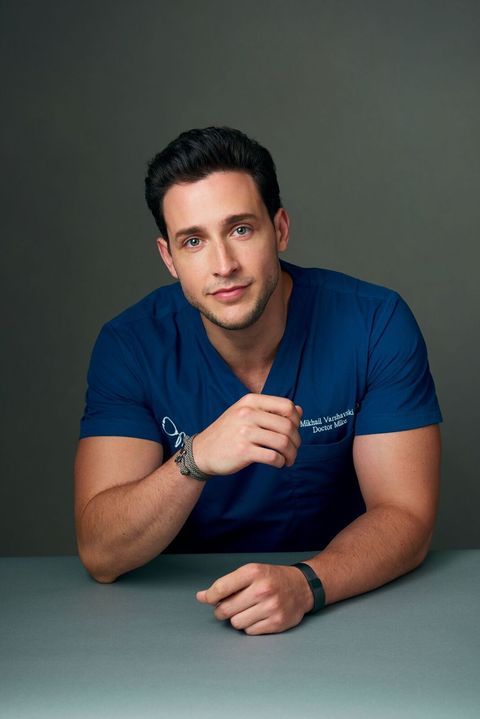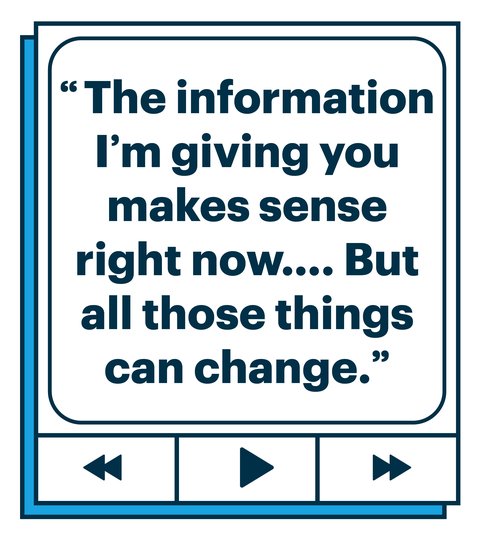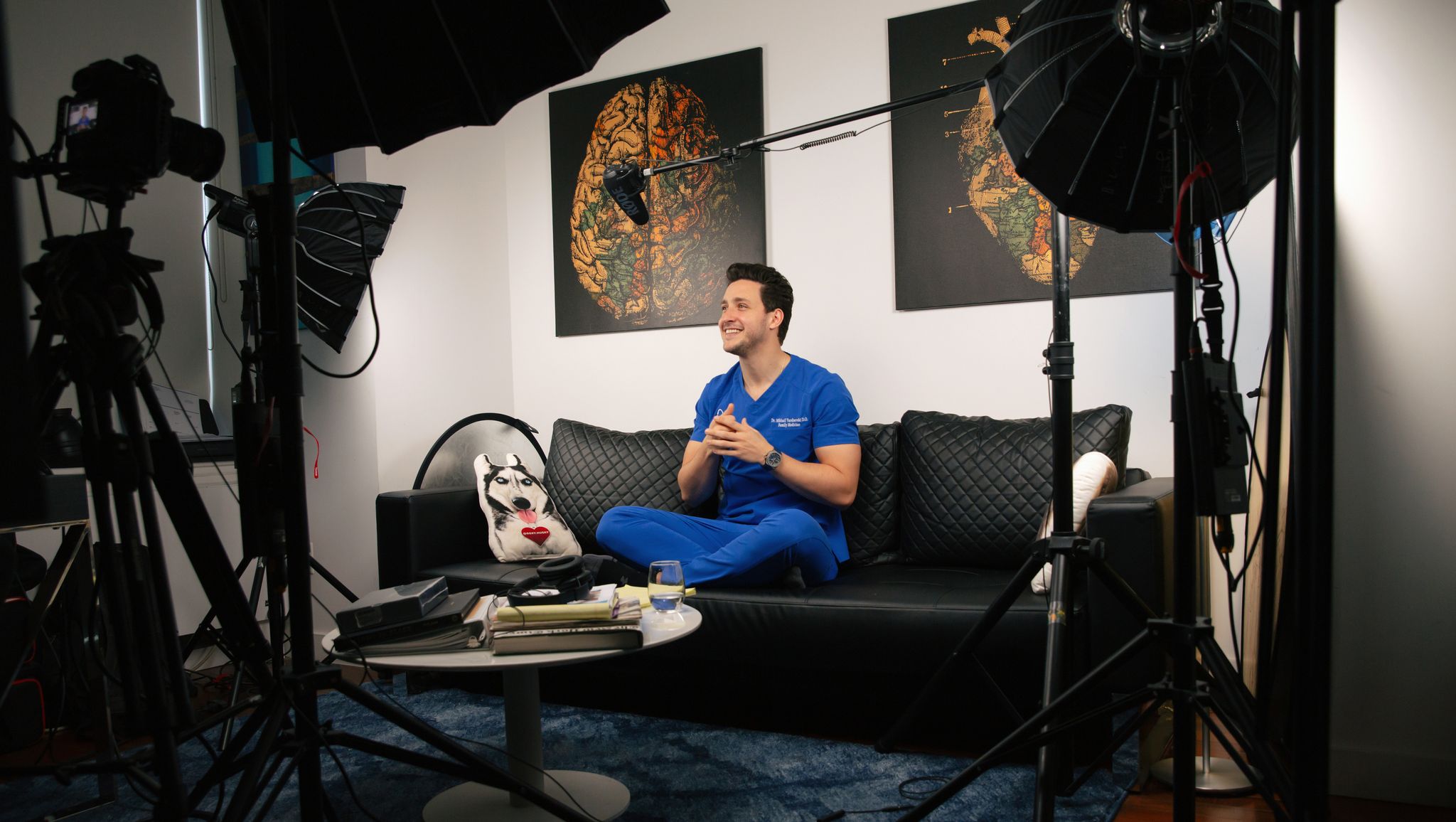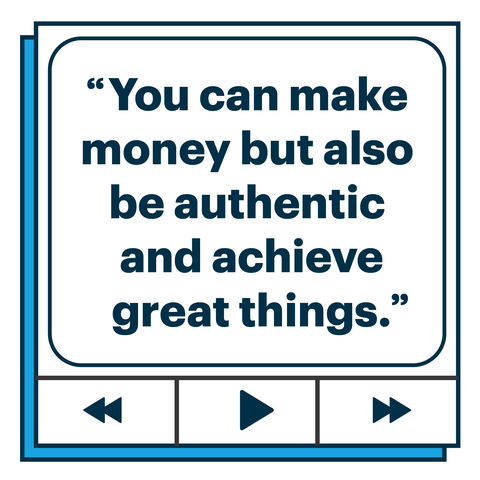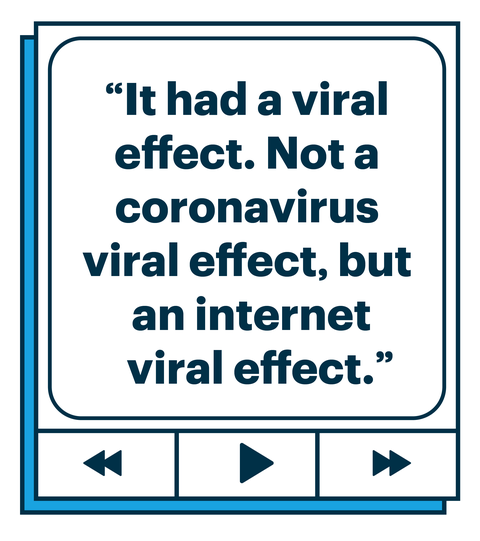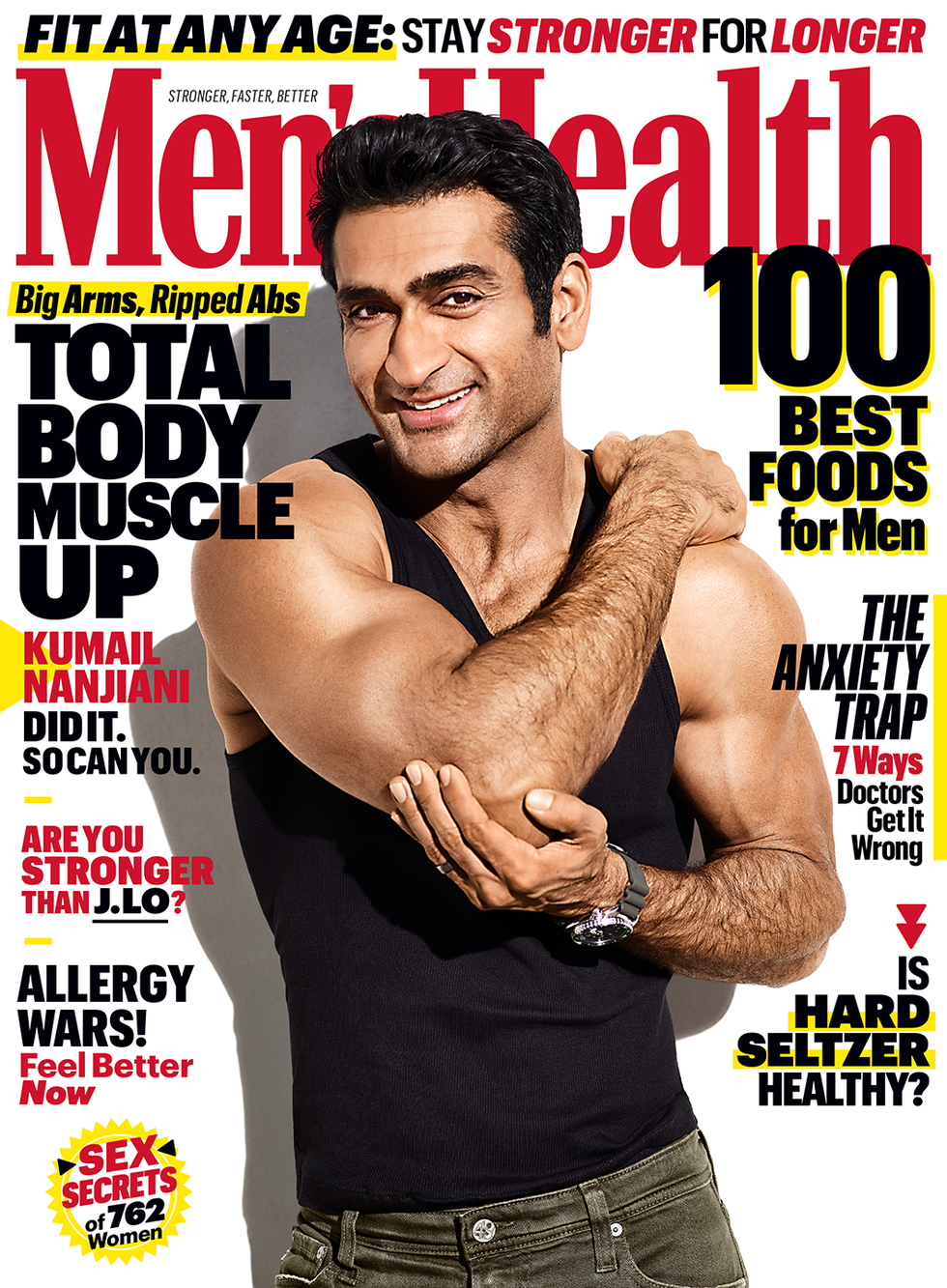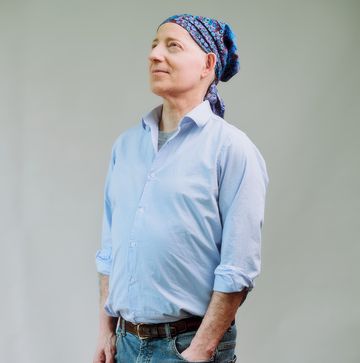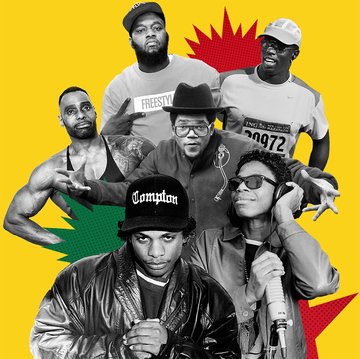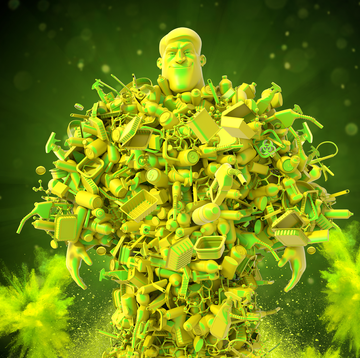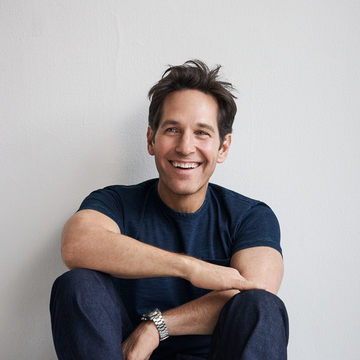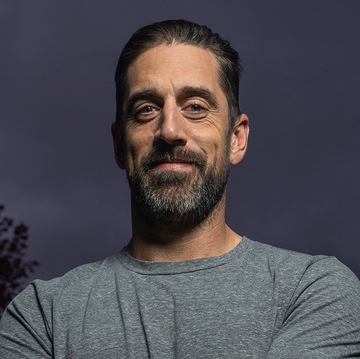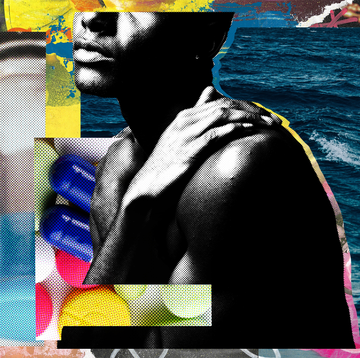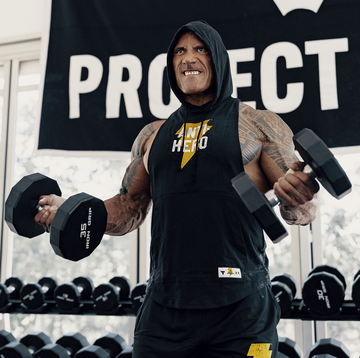THE CORONAVIRUS PANDEMIC has left most of us searching for a higher power. We sit in self-isolation with our windows cracked, praying spring air can dissipate the terror of watching the number of COVID-19 cases go up, up, up, and the stock market go down, down, down. We try to keep the faith that our shipments of toilet paper and coffee beans will come—why doesn’t Amazon sell liquor?—and that Google will tell us if it’s okay to ride bikes outside. We monitor our bodies with a mindfulness that would impress Marianne Williamson. And we wait for divine intervention: an antiviral treatment, herd immunity, a vaccine, a cure.
But what counts as a miracle in the age of COVID-19 is delivered on YouTube by a 30-year-old man who looks like a cast member from Grey’s Anatomy but is, in fact, a real-life physician—albeit one who, until recently, was mostly posting YouTube videos with titles like, yeah, Real Doctor Reacts to Grey’s Anatomy. “Oh my God,” Doctor Mike says from a couch in his Manhattan home in a March 8 YouTube video titled Doctor Fact-Checks Media On Coronavirus. “There is so much misinformation going on with this novel coronavirus, it boggles my mind.” Then, as the self-appointed ombudsman of public health, he dismantles each of those pieces of misinformation.
In the video, Doctor Mike is aghast that CNBC commentator Rick Santelli recently suggested that COVID-19 is like the flu and that it might be better for everybody to get it at once, because “then in a month it would be over.” “That is a horrible idea and a horrible sentiment, not only because it’s cruel [and] people are going to die,” Doctor Mike says, “but it’s not scientifically warranted.... We absolutely need to slow this thing by quarantining individuals so that we can get these medications made, approved, safety-tested.”
No, he explains, it’s not responsible for White House economic advisor Larry Kudlow to claim the government’s containment of the outbreak is “close to airtight.” “It’s not even remotely close to airtight!” Doctor Mike says before reviewing the steps that have been taken to control the spread. No, he tells us, nonexperts shouldn’t share unfounded information. “The last thing I want to see is one more picture of Gwyneth Paltrow wearing a fancy, $200 face mask,” he says, “claiming that that’s how she stays safe, because she was in the movie Contagion and she knows what’s up. No, that’s goop. And when I say goop, I meant poop.”
A March 18 dispatch titled Doctor VS Coronavirus Conspiracy Theories features a thumbnail of Homer Simpson and dispels the myth that you can sanitize your hands with Tito’s vodka. If you listen closely, you can hear trance music playing at a tasteful volume in the background, one of Doctor Mike’s many commonly used attention-holding tactics, like highlighting text as it’s read and displaying amusing onscreen graphics. In a March 15 video, Doctor Mike coins the evocative term “germ hang time,” which brings to mind Michael Jordan’s iconic 1997 flu game. “I like to call it edutainment,” Doctor Mike told me over the phone a few days ago. (We couldn't meet in person because, well, because.) “Where it’s like education/entertainment.”
Doctor Mike films some of these videos in monogrammed scrubs—the cursive D and M combine to resemble a floridly coiled stethoscope—and delivers his gospel of truth with eyes wide enough to express his concern and show how blue they are and a mouth open enough to clearly enunciate each medical term and expose his perfect teeth. His energy is carefully calibrated to keep viewers, as he says in many videos, “alert, not anxious.”
He’s streaming at a moment that seems to be the perfect storm for him to break through. We live in a culture obsessed with reality tv personalities; a culture that doesn't trust medical establishment; a generation that primarily gets its content from YouTube. The world is panicking in the midst of a once-in-a-lifetime health crisis. Doctor Mike fills the void in all of that. His channel has more than 5 million subscribers and 500 million views, impressing even skeptical New York Times media columnist Ben Smith, who described him as a “solid” source of health information for young people. (Doctor Mike got his degree in osteopathic medicine from the New York Institute of Technology. Osteopaths approach wellness holistically, and osteopathic physicians are fully licensed with the same privileges as traditional M.D.s.)
But is it really a good idea to take advice from strangers on the Internet? Though Doctor Mike constantly directs people to the CDC—there is a link to the federal agency’s website underneath all of his coronavirus videos—he’s aware most of us lack the patience to parse complex data. He sees the kind of confusion that leads some to drink bleach and others to decline to let the pandemic interrupt their spring-break plans as coming from a deluge of information that makes it hard to contextualize just how much each news alert should alter our behavior. He recognizes it’s easier to find things online that confirm our biases than to seek what might confound them. He understands that the people we look to for guidance are often the most famous but rarely the most informed. And like tricking a dog into swallowing medicine by smothering it in peanut butter, he knows that the way to deliver crucial medical data is in a Doctor Mike video: short, colloquial, and delivered by someone quite knowledgeable and quite hot.
BEFORE HE BECAME Doctor Mike, Mikhail Varshavski was born in the Soviet Union in 1989. When he was a child, his family moved to Bay Ridge, Brooklyn because of virulent anti-Semitism in his home country: Doctor Mike says his father, Oskar, “worked in the local [Russian] police force as a doctor but knew that he could never go past that rank, simply because he was Jewish.” When Oskar got to the U.S., he had to repeat his training to be able to practice medicine.
It was around this time that “Doctor Mike” was christened as such by his classmates, who figured he had received enough secondhand information from his father’s double stints in medical training that he could diagnose their sports injuries. “Most kids don’t get to see their parents go through medical school,” Doctor Mike says. “While I got to witness that, I saw how much BS there was out in the world of folks making claims for supplements, for rapid weight-loss cures, for detox teas, snake oil. I would say, ‘Why would people do this if they want to help people, if they spent ten years going through medical school?’ Many people think they have to give up their morals to be successful financially. I’ve always grown up with the theory that you can make money but also be authentic and achieve great things.”
This is the paradox of someone succeeding in a crisis, as Doctor Mike is; though he still practices family medicine in suburban Chatham and Summit, New Jersey, he estimates 99 percent of his income comes from media and his YouTube channel, and subscribers have jumped 20 percent since he started posting coronavirus videos. (Though online marketplace OnBuy.com offered the unsubstantiated estimate that Doctor Mike makes $500,000 a month, his publicist says the actual figure is lower.) “Ignore people trying to make a buck in this situation,” says Doctor Mike in a video that dismisses immune-boosting supplements as “poo poo.” “In fact, those who are doing so should be ashamed of themselves,” he tells us. But is it really profiteering if the thing making you money is the dissemination of vital public-health information?
Doctor Mike’s initial goals were, if not impure, at least perhaps inherently less noble than curbing a global pandemic. While he was studying for his osteopathic medical boards in 2013, he says a nursing student told him, “Mike, you do really well in medical school, but you also have a really healthy balance of exercise, social life. Why don’t you tell people about it?” (Many of Doctor Mike’s stories feature people complimenting him, which feels less like bragging than a sober statement of obvious fact.)
In one year, Doctor Mike gained enough of an Instagram following that Buzzfeed wrote what can only be described as a deeply horny article called “Um, You Really Need to See This Hot Doctor and His Dog,” featuring thirst posts of Doctor Mike cavorting with his similarly cobalt-eyed husky, Roxy. “It had a viral effect,” he says, helpfully clarifying it was “not a coronavirus viral effect, but an Internet viral effect. I picked up a million followers in a matter of days. Ellen DeGeneres was calling. Steve Harvey’s show is calling. ‘Come on our show.’ ‘Come on our show. Don’t do theirs.’ Even The Bachelor reached out and tried to convince me.”
Doctor Mike elected to make his television debut on Ellen in April 2014 but quickly learned that low-level Internet fame is a perishable commodity. His appearance was bumped by Hillary Clinton coming on the show to announce she was running for president. When the hot doctor went crawling back to Steve Harvey and the other shows on his hot knees, he was told, he says, that he was “old news.” Then Doctor Mike had an epiphany: He could Trojan-horse discussions of preventive care through his hot-doctorness. “I said, Wait, what if I make this my own, and we do the hot doctor thing to get people to watch, but then we don’t have to corrupt the medical information?” (In case I had forgotten that he is in fact a hot doctor—and I had definitely not—he then added, “Because people are watching for the hot-doctor thing.”)
Doctor Mike began showing up on Good Morning America, Today, Rachael Ray, and weekly on Maria Bartiromo’s Fox Business show. In 2015, he was named one of People’s Sexiest Men Alive. That exposure propelled him to launch his YouTube channel, two years and 228 videos ago. The first entry is a flex: Doctor Mike modestly introduces himself to the low-res camera from his couch, cuing b-roll of him getting out of bed, pulling his dripping muscles out of a pool, and heading to the hospital to save lives, all over the soundtrack of soundbites from Chris Harrison, Kelly Ripa, and Ryan Seacrest extolling his vast attractiveness and number of followers. “How do you become this famous, sexy doctor?” the also famous and sexy Dr. Oz asks him. Doctor Mike’s myriad of TV appearances and charity work with organizations like Stand Up to Cancer are highlighted before he delivers his mission statement: “Medicine doesn’t have to be sad. We can have a good time!”
Yes, with his videographer and lone creative partner, Daniel Owens, Doctor Mike has made videos about nose picking and the inaccuracies of the TV series House. But he also uses his platform to debunk the kind of miracle cures espoused by his fan Dr. Oz—including zinc supplements that allegedly slow the spread of coronavirus—with his own miracle cure: honesty (and being willing to point to the exact study that’s being misinterpreted). Part of this is admitting that there isn’t always a miracle, or even an answer. “I’m a big fan of the phrase ‘I don’t know,’ ” Doctor Mike tells me. “It needs to be followed with ‘We don’t know, but here’s what we’re doing to find out,’ or ‘Here’s why we don’t know,’ and ‘Here’s why nobody would know.’ Because what happens is if you just leave it, ‘I don’t know,’ there’s a knowledge vacuum. People jump in. Sometimes like the president. Sometimes like a conspiracy theorist. They’ll come in and they’ll give their theory for what’s going on without much scientific backing.”
And that is why on January 29, ten days after the first U.S. case was identified and four days before President Trump said, “Well, we pretty much shut it down coming in from China.... We can’t have thousands of people coming in who may have this problem, the coronavirus. So we’re gonna see what happens, but we did shut it down,” Doctor Mike began creating videos about a disease called COVID-19. “I just didn’t want to make this video too soon,” he says, “because I didn’t have enough information to give you practical, useful guides.” He explains what a novel coronavirus is (an animal virus that mutates so it’s able to replicate in humans), what the symptoms are (fever, cough, shortness of breath), how it spreads (airborne and surface particles), and what to do if you think you have it (go to the doctor if symptoms persist, though there is no treatment yet, only supportive care).
Doctor Mike reported the then-accurate news that the disease’s epicenter was Wuhan, China, which as of March 19 has stopped producing new cases. “All the statistics and all the information I’m giving you make sense right now,” he says, pointing down at the date below the video player.
Doctor Mike is aware that these videos have a shorter shelf life than, say, “How Much Coffee Is Too Much?” “That’s why with these coronavirus videos, I almost start it off like a scary movie,” he says. “I say, ‘Today’s date is March 13. Here’s everything you need to know up until this date. But remember, things can change.’ ” Though some of the coronavirus material has gotten millions of views, they aren’t Doctor Mike’s most watched videos. (Those would be his reactions to medical shows and memes, which have collectively been seen tens of millions of times.) But they have elevated a family medicine physician to be one of the faces of authority of a pandemic, without him needing to leave home.
“Our video was trending number four behind CNN, Today show, Fox,” he says of a recent COVID-19 video. "The first three thumbnails of those videos were the director of the NIH, and then the fourth one was Doctor Mike giving the same information in a clear, easy-to-understand way." He’s sharing knowledge more conversationally, yes. But it’s more than that. He’s unafraid to debunk or add important context to confusing messages shared by others, others in a way that more stylistically resembles Jimmy Kimmel’s “Mean Tweets” segments than the scientific explainers they are. “I think this coronavirus has been the best proof of concept ever for what I wanted to achieve,” he says. “Folks are panicking. They don’t trust the media. And they’re coming to my channel for reassurance.”
AS DOCTOR MIKE becomes more popular, he will test his own theory—“that you can make money but also be authentic and achieve great things”—with the scientific rigor we expect of him. He says much of the research that goes into the show also has practical application in his clinical work. (At the same time, the kind of respectful enticement he uses to get “vaccine-hesitant” parents to immunize their children scales to persuade his millions of viewers, though he also attributes this skill to an early affinity for the seminal striver’s guide How to Win Friends and Influence People.) He’s talking with production companies about having his own show on which, he hopes, “we’ll replace the doctors of yesterday.”
But it’s a lot easier to maintain your purity when you're making reaction videos in your room than when you have to produce five hour-long shows a week. Before Dr. Oz was being called out by the establishment for peddling silver bullets on daytime TV, he was the establishment. “You’re mostly right,” Doctor Mike corrects me in a calm, patient voice when I share my assessment of the celebrity doctor who appears in Doctor Mike’s inaugural YouTube video. “But when Oz was initially on Oprah, he held some really strange beliefs and brought on some really strange examples of health care early on, even—medical mediums and things like that. I mean, just as a practicing physician, you can’t. I don’t tell my patients to come in when they have a condition and say, ‘Pray your way out of it.’ That’s not helpful.” (Men's Health reached out to Dr. Oz for comment but had not heard back by press time.)
Similarly, Doctor Mike only makes endorsement deals he doesn’t have to guarantee positive coverage for, and he has taken money to showcase products from Audible, Thrive Market, and the health app Lifesum to his 3.5 million Instagram followers. Doctor Mike’s biggest partnership by far is with Nike; he was supposed to document his experience training for an April half marathon that has since been canceled due to COVID-19. “When we went to Nike World Headquarters and interviewed their shoe designer,” Doctor Mike says of his initial meeting with the brand, “we said, ‘Where did you get this information that this shoe reduces injuries?’ This is on camera, for our first Nike video we published. And they said, ‘Well, frankly, we don’t know what causes running injuries. So we said, You know what? Let’s flip the whole thing on its head and see if more cushioning and a less stable shoe performs better. And we tested it against another random Nike shoe that has more stability, and it did do better. We don’t know if that’s going to hold up against other shoes, but this is a good place to start.’ Once I saw them comfortable saying that they don’t know, but here’s what they’re trying to do, I said, ‘I’m comfortable passing along that message to my audience.’ ”
This week, amid a global health crisis that coincides with and has aided Doctor Mike’s professional ascent, he says videographer Owens said to him, “Sometimes it’s hard to wrap our heads around the fact that it’s us—two guys—sitting around my bedroom, and we’re affecting the decisions of millions of people.” And not just the ones watching his videos. In a comically charming act of heroism, Doctor Mike was on a flight to Israel last summer when he heard a flight attendant call out for medical help. Doctor Mike jury-rigged a heart-reviving epinephrine needle to administer the correct dose to save a man whose throat had closed in an allergic reaction. After the ordeal, Doctor Mike was approached by New York senator Chuck Schumer to join him in advocating for EpiPens to be available on all commercial planes.
“And when coronavirus happened,” Doctor Mike says, “his press secretary reaches out to me and is like, ‘Doctor Mike, what are we not doing? What do we need to do as the government?’ ” A spokesman for Senator Schumer confirms that his office informally talked to Doctor Mike and other physicians to get a sense of how COVID-19 is impacting their supplies.
Internet fame has given Doctor Mike a podium to reach not just the millions of people watching him on YouTube, but the elected officials who make the rules that govern those viewers. But as long as YouTubers follow the platform’s laissez faire community standards, there’s very little governance over them, even when they’re delivering information that can literally impact whether you live or die. Men’s Health reached out to experts from the Center for Infectious Disease Research and Policy, Weill Cornell’s Infectious Disease Department, the Division of Infectious Diseases at UNC, and the Johns Hopkins Center for Health Security and Bloomberg School of Public Health to ask whether Doctor Mike’s messages were accurate and responsible. Those who responded kindly let us know they were too busy dealing with the COVID-19 pandemic to watch YouTube videos, though Dr. Amir Barzin from UNC’s Department of Family Medicine cautions “it's difficult to know exactly what someone's personal views are or what you might find on social media.”
Everyone has their own biases. Even the divine Doctor Mike is fallible. And so far, when he's realized that he's caused controversy or confusion (or heard from commenters that he has), he's responded with his own updates. For now, we can keep our own earnest faith in Doctor Mike. Or, at the very least, our faith in Doctor Mike’s ambition to be famous for telling the truth.
“It’s funny,” Doctor Mike says. “As a YouTuber, you would think I just make silly videos. But I have a leading politician’s team reaching out to me. I have the WHO trying to figure out how we can work together during this coronavirus.” (Doctor Mike’s publicist says, “He’s taking advice from the WHO and using their talking points. They continually send us updates, and that’s how he’s working with them.”) Doctor Mike apologizes; he has to go. You see, he bought $50,000 worth of N95 masks for the hospital where he works, which is experiencing a shortage. He needs to go deliver them. And, oh yes, of course he will be making a video about it.
Anna Peele is a culture writer and editor who has written features for Esquire, GQ, The Washington Post Magazine, and New York Magazine.

